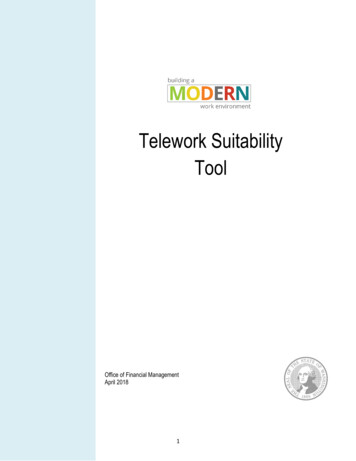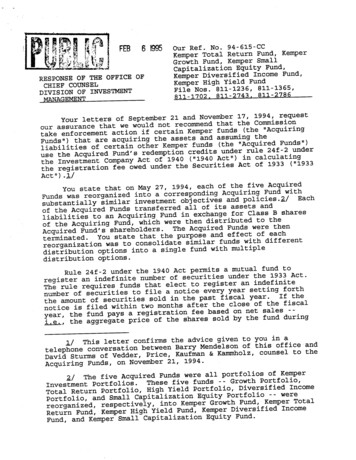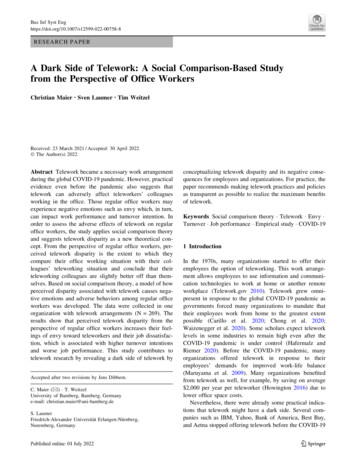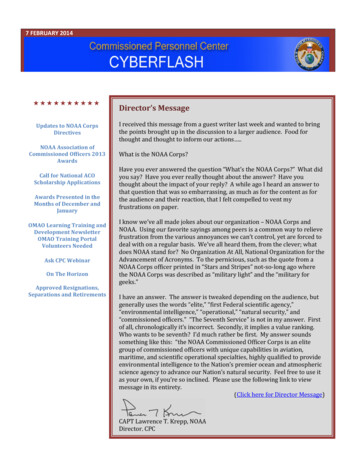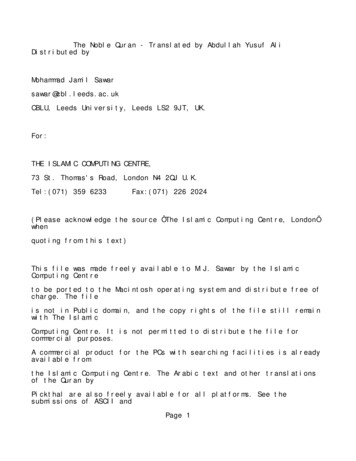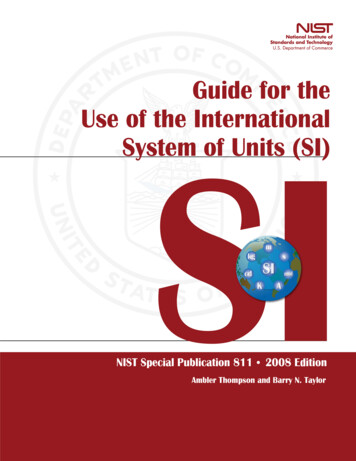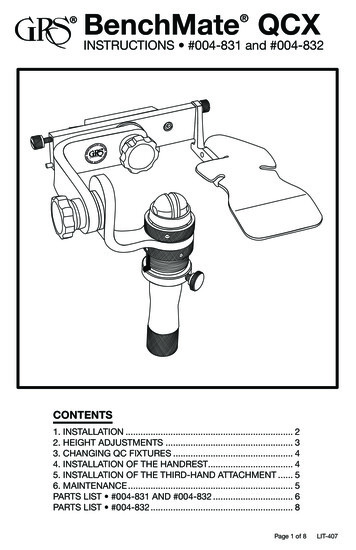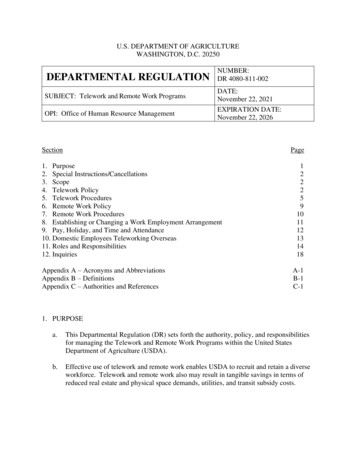
Transcription
U.S. DEPARTMENT OF AGRICULTUREWASHINGTON, D.C. 20250DEPARTMENTAL REGULATIONSUBJECT: Telework and Remote Work ProgramsOPI: Office of Human Resource ManagementNUMBER:DR 4080-811-002DATE:November 22, 2021EXPIRATION DATE:November 22, 2026SectionPage1. Purpose2. Special Instructions/Cancellations3. Scope4. Telework Policy5. Telework Procedures6. Remote Work Policy7. Remote Work Procedures8. Establishing or Changing a Work Employment Arrangement9. Pay, Holiday, and Time and Attendance10. Domestic Employees Teleworking Overseas11. Roles and Responsibilities12. InquiriesAppendix A – Acronyms and AbbreviationsAppendix B – DefinitionsAppendix C – Authorities and References122259101112131418A-1B-1C-11. PURPOSEThis Departmental Regulation (DR) sets forth the authority, policy, and responsibilitiesfor managing the Telework and Remote Work Programs within the United StatesDepartment of Agriculture (USDA).Effective use of telework and remote work enables USDA to recruit and retain a diverseworkforce. Telework and remote work also may result in tangible savings in terms ofreduced real estate and physical space demands, utilities, and transit subsidy costs.
2. SPECIAL INSTRUCTIONS/CANCELLATIONSThis DR supersedes the Step 1 interim telework guidance provided in Secretary Vilsack’smemorandum, Building a Model Workplace with Expanded Telework and WorkFlexibilities – Our First Steps, dated March 11, 2021, which repealed DR 4080-811-002,USDA Telework Program, dated January 4, 2018.All USDA organizations must ensure compliance with the provisions of this regulationand applicable labor relations obligations.Supplemental Guidance. To the extent the implementation of this directive may affectbargaining unit employees’ conditions of employment, management must fulfill itsstatutory labor relations obligations prior to the directive being implemented.Consequently, Mission Areas, agencies, and staff offices may supplement this directivethrough the collective bargaining process, with the sole exception of an agencydemonstrating a compelling need under the Federal Labor Relation Authority’sregulation set forth in 5 Code of Federal Regulations (CFR) § 2424.50, IllustrativeCriteria.3. SCOPEThis DR applies to all USDA Mission Areas, agencies, staff offices, organizations, andemployees.This DR requires close collaboration from Departmental, Mission Area, agency, andstaff office leadership and across all support functions.4. TELEWORK POLICYUSDA fully supports and promotes the use of telework for and by eligible employees.The USDA Telework Program is designed to fully implement the TeleworkEnhancement Act of 2010 and enhance work-life balance for employees.USDA permits telework up to 8 days per biweekly pay period based on the duties of theposition.A teleworker’s official duty station will remain unchanged if they report physically totheir employing office worksite location for 2 full workdays or a combination ofworkday and some form of personal leave each biweekly pay period on a regular andrecurring basis. If a holiday falls on a teleworker’s day to physically report to theemploying office worksite, it is not required to add an alternate day to the employee’srequirement to physically report to the employing office worksite for that specificbiweekly pay period.2
Telework should be used as a strategic tool to recruit and retain a diverse workforce andsupport employee work-life balance.Use of telework is a key component of USDA’s ability to operate in situations in whichworking from the official worksite is unsafe or unavailable. Unscheduled telework willbe considered and may be authorized or required during inclement weather, emergencysituations that involve national security, extended emergencies, or other uniquesituations as determined by the Office of Personnel Management (OPM) or USDA.Mission Area, agencies, and staff offices should incorporate telework into theirContinuity of Operations Plan (COOP).Eligibility(1) All USDA employees, regardless of tenure, grade, job series, title, or supervisorydesignation are presumed eligible for telework unless prohibited by otherexclusionary provisions of this regulation or negotiated as part of a collectivebargaining agreement (CBA).(2) Employees occupying a telework eligible position may telework up to 8 days perpay period based on the duties of the position and the amount of onsite activitiesthat must be performed. Employees, in positions ineligible for telework and thoseperforming similar functions will be treated as fairly and equitably as those thattelework. All approved telework arrangements must be documented on anAgriculture Department (AD) 3018, USDA Telework Agreement form and mustconform to any applicable negotiated labor agreement.(3) Positions may be identified as ineligible for telework based only on the followingcriteria:Position duties require daily physical presence and do not include any portableor administrative work that can be accomplished from an alternate office orlocation.Position responsibilities require daily access to specialized equipment locatedat the official worksite and do not include any portable or administrative workthat can be accomplished from an alternate office or location.Position activities require daily access to classified materials and do notinclude any portable or administrative work that can be accomplished from analternate office or location.(4) Employees may be identified as ineligible for telework based only on the followingcriteria:(a) Performance. An employee may be found ineligible for telework if theirperformance falls below fully successful. In such circumstances, supervisors3
are required to initiate corrective action in accordance with DR 4040-430,Employee Performance and Awards. The employee's eligibility for teleworkmust be reassessed every 12 months from the date the supervisor determinedthat the performance fell short.(b) Conduct. An employee may be found ineligible for telework if the employeewas subject to formal disciplinary action, adverse action, or was placed on aleave restriction within the previous 12 months.(c) Permanent Ineligibility. As specified in the Telework Enhancement Act, anemployee is permanently ineligible for telework if they have been formallydisciplined for the following:1Violation of 5 CFR Part 2635, Subpart G, Misuse of Position, of theStandards for Ethical Conduct for Employees of the Executive Branch forviewing, downloading, or exchanging pornography, including childpornography, on a Federal Government computer or while performingtheir official duties; or2Absence Without Leave (AWOL). AWOL is a non-pay status that coversan absence from duty that is not approved. Any USDA employee AWOLfor 5 or more days in any calendar year is permanently ineligible.Temporary Eligibility. In certain circumstances, an agency may temporarilydesignate the location of the agency worksite for an employee’s position(i.e., the place where the employee would normally work, absent a Teleworkagreement) as the official worksite even though the employee is not able toreport at least twice each biweekly pay period on a regular and recurring basisto the Mission Area, agency, or staff office worksite. The employee must beexpected to return to the Mission Area, agency, or staff office worksite at somepoint in the future on a regular and recurring basis. It is the responsibility ofthe employee’s immediate supervisor to decide when it no longer is proper toapply the temporary exception. However, if a teleworking employee is notexpected to report to the Mission Area, agency, or staff office worksite on aregular and recurring basis in the future, the temporary exception would nolonger be applicable. Supervisors must periodically review (at least every 3months) an employee’s temporary full-time telework arrangement to ensureany approved temporary exception continues to apply. A supervisor maywaive this requirement on a temporary basis in situations such as:1Recovery from an injury or medical condition;2Emergency conditions that prevent an employee from commuting to theofficial worksite, such as a severe weather emergency or public healthcrisis;4
3An extended period of approved absence from work, e.g., paid leave;4A period during which the employee is in temporary duty travel statusaway from the official worksite; or5A period during which an employee is temporarily detailed to work at alocation other than a location covered by a Telework agreement.Telework should be considered, when appropriate, for reasonableaccommodation requests for employees with a disability or for accommodationof religious beliefs. All reasonable accommodation requests, including thosefor telework, must comply with DR 4300-008, Reasonable Accommodationsand Personal Assistance Services for Employees and Applicants withDisabilities.5. TELEWORK PROCEDURESTelework Participation(1) Telework agreements remain in effect until a change is initiated, though it is a goodpractice for supervisors to review telework agreements with employees on anannual basis. Either management or an employee may initiate a change to aTelework agreement with a minimum of 45 calendar days advance writtennotification, or as required by the terms of a CBA, except in emergency situationswhere the timeframe may be shorter.Teleworking employees are expected to perform their duties andresponsibilities at an acceptable level of competence. In accordance with theterms and provisions of any applicable CBA, participation in telework may bechanged, suspended, or terminated by management if an employee no longermeets the eligibility criteria or performance expectations.Management will provide sufficient written notice if possible, usually at least45 calendar days, or as required by the terms of a CBA, before changing,suspending, or terminating a Telework agreement to allow the affectedemployee to make necessary arrangements. The notice will include the reason,effective date, and any appeals or grievance procedures available to theemployee. Consent or acknowledgement via signature by the employee is notrequired for the modification or termination to take effect.Changes (e.g., change in position or change requested by management oremployee) will require a new or updated Telework agreement to be completed.A new Telework agreement is not needed for temporary changes in position orsupervisor (e.g., due to detail, temporary promotion, or assignments of a shortduration).5
(2) In accordance with this DR and the terms and provisions of any applicable CBA,management reserves the right to call employees back to the office, even onscheduled telework days, with at least a 24-hour notice.(3) Teleworkers and remote workers may participate in flexible and compressed workschedules or other flexible work arrangements.(4) Telework is voluntary for all USDA employees. At a minimum, every employeemust decide either to participate in the telework program or affirmatively opt out ofthe telework program by completing the AD-3018 form and giving it to theirimmediate supervisor.Unscheduled and Emergency Telework(1) OPM or USDA authorized officials may announce emergency operating statusguidance allowing for unscheduled or required telework beyond that outlined in theOPM early dismissal guidance for weather events.(2) Management may order employees to evacuate from their worksite and performwork from their home, or an alternative location, during inclement weather, publichealth crisis, or other emergency without regard to whether the employee has aTelework agreement in place at the time the order to evacuate is issued.Departmental and Mission Area, agency, or staff office COOPs should be followed.(3) Employees with a Telework agreement are expected to telework or take otherauthorized leave (paid or unpaid), paid time off or a combination of both, asapproved by the Mission Area, agency, or staff office.(4) Teleworkers generally are ineligible for weather and safety leave when a closure isannounced, except in rare circumstances:Weather and safety leave may be granted to a telework-ready employee who, inthe Mission Area, agency, or staff office’s judgment, could not have reasonablyanticipated the severe weather or other emergency condition so did not takehome needed equipment or work.Weather and safety leave may be granted to a telework-ready employee who isprevented from safely working at the alternate site because of the severeweather or other emergency event (e.g., electrical power or broadband outage,fire, flooding or heating and cooling failures). In this case, the home or otherapproved telework site is also affected in such a way that work cannot be safelyperformed. Employees must communicate with their supervisors as soon aspossible when such work disruptions occur. For more detailed guidance relativeto weather and safety leave regulations see 5 CFR § 630.1603, Authorization,and OPM’s Governmentwide Dismissal and Closure Procedures.6
Teleworkers who are working in the office when an early departure isannounced generally may receive weather and safety leave for time required tocommute home (excluding the period for an unpaid lunch break. This meansthat telework participants must complete the remaining hours of their workday(if any) either by teleworking or taking leave (paid or unpaid) or other paid timeoff once they arrive home.Time and Attendance (applies to teleworkers and remote workers)(1) Employees must follow their Mission Area, agency, or staff office-specificprocedures for accurately coding time spent teleworking and working remotely.(2) USDA procedures for requesting and approving overtime, credit hours, and leaveapply to all USDA employees, including teleworkers and remote workers.Safety(1) USDA encourages teleworkers and remote workers to be proactive in ensuring asafe alternate worksite and safe work habits.(2) As a remote worker or while teleworking from an alternate worksite, USDAemployees may be covered by the following:Federal Tort Claims Act (FTCA), 28 United States Code (U.S.C.) §§ 26712680, Tort Claims Procedure; andFederal Employees’ Compensation Act (FECA), 5 U.S.C. Chapter 81,Compensation for Work Injuries.(3) Employees are covered by FECA at their alternate worksite if an injury occurswhile performing their official duties.(4) If an injury occurs, the employee must notify their supervisor immediately, providedetails of the incident or injury, and complete the following Department of Labor(DOL), Occupational Safety and Health Administration (OSHA) forms:(a) OSHA, Form 301, Log of Work-Related Injuries and Illnesses; and(b) DOL, FECA Form CA-1, Federal Employee's Notice of Traumatic Injury andClaim for Continuation of Pay/Compensation; or(c) DOL, FECA CA-2 Form(s):1Form CA-2, Notice of Occupational Disease and Claim forCompensation; and7
2Form CA-2a, Notice of Recurrence; and(d) As applicable, for Federal Employee’s Notice of Traumatic Injury and Claimfor Continuation of Pay/Compensation (CA-1) situations, employees canaccess the DOL Employees’ Compensation Operations and Management Portal(ECOMP) through the How to File a Form website.(5) The Government is not liable for damages to the employee’s personal or realproperty while the employee is teleworking, except to the extent the Government isheld liable by the FTCA.Reasonable Accommodation and Medical Telework(1) An employee seeking to telework or work remotely as a reasonable accommodationis required to follow the policies and procedures outlined in DR 4300-008.(2) It is not a requirement to document or track a Telework agreement or a MissionArea, agency or staff office unique remote work agreement approved for areasonable accommodation. However, written documentation in another formatmay be needed to document the efficacy of the organization’s reasonableaccommodation arrangement with the employee.Telework Appeals(1) Appeals of the denial of an employee’s request to telework are governed by DR4070-771-001, Administrative Grievance System, or the applicable negotiatedgrievance procedure for bargaining unit employees.(2) Employees may appeal the following denials of telework:A written decision of ineligibility based on the duties of the position or theemployee’s suitability for telework;Denial of an employee’s request to telework documented by the submission ofa Telework agreement;Management termination of an existing Telework agreement; andDenial of an employee’s request to telework without a valid business reasonyet, the employee is approved for ad hoc telework.6. REMOTE WORK POLICYUSDA fully supports and promotes remote work arrangements for and by employeesoccupying remote work eligible positions. The USDA remote work policy as describedin this DR is intended to enhance the work-life balance for employees.8
OPM permits Mission Areas, agencies, and staff offices to develop their own agencyspecific remote work policies and forms and to implement a strategic andcomprehensive framework for such policies. While employees and organizationsbenefit from remote work arrangements, such arrangements are subject to a MissionArea, agency, or staff office’s budget, business and operational needs, this DR, and theterms and provisions of any applicable CBA. USDA organizations must create formalremote work agreement forms to document employee requests, approvals and denials ofremote work opportunities.Remote work is an arrangement under which USDA employees are scheduled toperform their position’s job duties at an approved alternate worksite, typically theemployee’s residence. The remote worksite may be within or outside of the localcommuting area of the Mission Area, agency, or staff office’s worksite. Remote workemployees will be expected to work at a designated approved location, typically theemployee’s residence, on a regular and continuing basis.Remote work arrangements may be used for a variety of business reasons, including, butnot limited to:(1) Retaining high performing employees who must move for personal reasons andwould otherwise leave the USDA;(2) Recruiting employees with specialized skills, who may not want or be able torelocate for personal reasons;(3) Achieving Mission Area, agency, or staff office real estate or other business costreductions;(4) Reducing costs associated with filling vacancies when employees must relocate;and(5) Increasing employee work-life balance, resulting in increased morale.Remote Work Eligibility. At a minimum, the following conditions or criteria will beconsidered when a remote work arrangement is requested or when included in a JobOpportunity Announcement (JOA):(1) As part of the ongoing position management processes, each USDA Mission Area,agency, or staff office will review positions to determine eligibility for a remotework arrangement. Eligibility must be determined prior to posting a JOA; and(2) A Mission Area, agency, or staff office must consider:Job duties that only can be performed onsite and the amount of time required tocomplete such duties in a typical bi-weekly pay period;9
The amount of time required each week to participate in other aspects of thework unit operations such as training, meetings, or collaboration, includingcollaboration with stakeholders that cannot be conducted virtually;The type and frequency of travel associated with the position; andAny requirement for accessing classified information.7. REMOTE WORK PROCEDURESAlthough remote employees generally are not expected to report to the Mission Area,agency, or staff office worksite, the supervisor can require the presence of a remoteemployee at the worksite in certain situations, e.g., random drug testing, training, or anofficial meeting. Supervisors should provide as much advance notice as possible.Remote work arrangements should be cost-neutral or low-cost, to the extent practical,after factoring in the net cost savings accrued moving each employee to a remotearrangement. Supervisors should minimize official travel between the remote worklocation and the Mission Area, agency, or staff office worksite unless necessary toaccomplish mission critical or operational needs or where alternative virtualcommunication means (e.g., teleconference, virtual meetings) are not suitable oravailable.When travel is required, clear communication between the employee and supervisor willensure an accurate understanding of mutual responsibilities and obligations. When aMission Area, agency, or staff office authorizes a remote employee to travel to an officeworksite for official duty, the agency will pay travel costs consistent with applicabletravel regulations and policies.Remote employees must be treated equitably for appraisals of job performance, training,awards, reassignment, promotions, changes in grade, work requirements, approval ofovertime work, flexible and compressed work schedules, and other actions withinmanagement’s discretion. Remote employees are entitled to receive progress reviewsand annual performance appraisals from their supervisors in accordance with USDA’sperformance management policies.8. ESTABLISHING OR CHANGING A REMOTE WORK ARRANGEMENTWhen creating a JOA, hiring managers must identify:(1) Whether the position is eligible for a telework or remote work arrangement; and10
(2) Whether a remote work arrangement is required for the position. Candidatesaccepting a position where a remote work arrangement is required must accept thearrangement as a condition of employment.USDA employees may request to work remotely, to change an existing remote workarrangement, or to terminate their remote work arrangement. Absent urgentcircumstances and in accordance with the terms of an applicable CBA, employeerequests to change their remote work location or remote work arrangement is limited toonce every 6 months. The employee requesting a change must:(1) Discuss the request with their supervisor. Changing the employee’s duty stationlikely will affect the employee in several ways (e.g., locality pay, Reduction-inForce (RIF) competitive area, bargaining unit status, unemployment compensation).When discussing such requests with the employee, management must address otheravailable workplace flexibilities, including but not limited to, alternative workschedules, details, leave options (e.g., extended leave without pay (LWOP), andshared leave programs.(2) The employee then may submit a request for a remote work arrangement, change toa remote work arrangement, or termination of a remote work arrangement inwriting. The request must include the proposed duty station and effective date.To the extent the eligibility criteria in Section 6e(2) of this directive are met, supervisorsnormally will approve requests to set up a remote work arrangement from employeesoccupying positions that are remote-eligible. Supervisors may consider, however,whether there is a need to limit the geographic location of the duty station for the remotework arrangement due to travel or other mission requirements.Supervisory considerations of employee requests to change or terminate a remote workarrangement include:(1) That the proposed creation or change of a remote work arrangement does notnegatively affect the Mission Area, agency, or staff office’s budget or ability toexecute its mission; and(2) Requests to terminate a remote work arrangement may be denied due to spacelimitations within a Mission Area, agency, or staff office worksite.Generally, to the extent the eligibility criteria in Section 6e(2) of this directive arepresent, employees may be considered eligible for a remote work arrangement.However, as with telework, an employee becomes permanently ineligible for a remotework arrangement if they have been formally disciplined for either:(1) A violation of Subpart G, Misuse of Position, of the Standards for Ethical Conductfor Employees of the Executive Branch for viewing, downloading, or exchangingpornography, including child pornography, on a Federal Government computing11
device to include cell phones and tablets or while performing official, FederalGovernment duties; or(2) Absence without leave (AWOL) for 5 or more days in any calendar year.Performance and Conduct. Employees on remote work arrangements are subject to thesame laws, rules, regulations, and policies that address performance deficiencies andemployee misconduct.In USDA, appeals to a denial of a request for a remote work arrangement are governedby DR 4070-771-001or the applicable negotiated grievance procedure for bargainingunit employees.9. PAY, HOLIDAY, AND TIME AND ATTENDANCEThe basic rate of pay of a remote employee is determined by the employee’s base payrate, the applicable locality pay rate and any special pay rate associated with theemployee’s official duty station of record, as recorded on the employee’s OPM StandardForm (SF)-50, Notification of Personnel Action. For remote employees, the officialworksite typically is their residence.Teleworker and remote workers are required to follow Departmental policies andprocedures for requesting and using approved leave. Leave should be requested andapproved in accordance with standard leave approval procedures, with leave hoursaccurately recorded in the time and attendance system.Mission Areas, agencies, and staff offices generally should not pay relocation expensesrelated to remote work arrangements such as expenses to relocate to a new official dutystation or to return to the Mission Area, agency, or staff office worksite when sucharrangements were requested by the employee and is not the result of a directedreassignment.Remote work employees traveling on official business are eligible for the same travelbenefits as non-remote work employees. Supervisors should, whenever possible,minimize official travel for remote employees. Alternate communication technologiesshould be leveraged to the greatest extent possible to minimize travel unless necessary.Remote work employees generally will not have an assigned or dedicated workspace atthe Mission Area, agency, or staff office worksite. Performance issues of remoteemployees will be addressed in accordance with USDA policies, regulations, andapplicable CBA provisions. Absent exigent circumstances, supervisors are expected toallow the employee to continue as a remote employee while addressing performance orconduct issues in accordance with USDA policies and in accordance with the terms andprovisions of any applicable CBA.12
All required training and travel for remote employees as determined by the supervisor(e.g., mandatory participation at meetings or conferences at the Mission Area, agency, orstaff office worksite) will be subject to normal training approval requests, applicabletravel regulations, and Mission Area, agency, or staff office funding.Remote work employees may be eligible for Workers' Compensation benefits for workrelated injuries or illnesses sustained while in the performance of duty under FECA,which is administered by the DOL’s Office of Workers’ Compensation Programs(OWCP). For further information, see 5 U.S.C. 81.10. DOMESTIC EMPLOYEES TELEWORKING OVERSEASDomestic Employees Teleworking Overseas (DETO) are overseas work arrangementsthat allow Federal Executive Branch employees to perform the work requirements andduties of their positions temporarily from approved overseas locations via DETOagreements. Employees have no authorization to telework from a foreign locationwithout approval from USDA and the Department of State (DOS).USDA employees who may be considered for a DETO are those who are the spouse ordomestic partner of a sponsoring Foreign Service Officer, Federal Civil Serviceemployee, Department of Defense (DoD) employee, or uniformed service memberassigned overseas. To be considered for a DETO, the USDA employee must be on theU.S. Government orders of the sponsoring individual assigned overseas.DETO requests will be considered on a case-by-case basis. Employees must consultwith the OHRM as early as possible in the process because DOS approval can take from6 months to a year, if not longer.Any DETO request must be approved by the applicable Mission Area, agency, or staffoffice prior to submission to the DOS and must follow the requirements in this DR, theDOS Executive Secretary Memorandum, Requirements for Executive Branch EmployeesTeleworking in Foreign Locations, dated June 7, 2016, and the DOS Foreign AffairsManual (FAM), 3 FAM 2370, Domestic Employee Teleworking Overseas (DETO)policy guidance, dated August 11, 2021.Before approval, the employee must complete a DETO agreement using the DOS DETOagreement form, fulfill any overseas training requirements, and obtain properdocumentation (e.g., passports, visas, work permits) to perform work overseas. Thecompleted DETO agreement must be submitted through the employee’s supervisorychain of command for approval. Once approved, it must be submitted to the DOS.A DETO may entail significant costs to the Mission Area, agency, or staff office, theemployee, or both. Therefore, prior to approving a DETO agreement, the applicableMission Area, agency, or staff office must be prepared to address any contingencies or13
problems with the overseas telework arrangement, including situations when theemployee or Mission Area, agency, or staff office may need to terminate the DETO.Upon approval of a DETO agreement, the approved case must be forwarded to theservicing Human Resource Office to change the employee’s duty station to the overseaslocation. The DOS regulation 3 FAM 2370 governs the availability of overseasallowances, including the termination of locality pay, and other differentials foremployees.DOS policy requirements apply to all employees working under a DETO.11. ROLES AND RESPONSIBILITESThe Director, Office of Human Resource Management (OHRM) serving as the USDAChief Human Capital Officer (CHCO), or designee, will serve as the TeleworkManagement Officer (TMO), as required by the Telework Enhancement Act of 2010.The TMO will:(1) Advise the S
(2) Management may order employees to evacuate from their worksite and perform work from their home, or an alternative location, during inclement weather, public health crisis, or other emergency without regard to whether the employee has a Telework agreement in place at the time the order to evacuate is issued.
